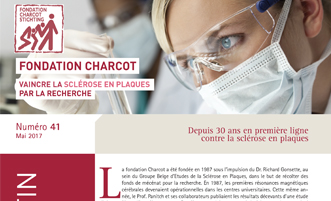The Charcot Foundation was founded in 1987 at the instigation of Dr Richard Gonsette, within the Groupe Belge d’Etudes de la Sclérose en Plaques, to collect funds for research. The first magnetic resonance imaging scans began to be used in university centres in 1987. That same year, Dr Panitch and his colleagues published the disappointing results of a clinical study on the use of interferon gamma. The product increased the frequency of flare-ups! This negative result was nevertheless the starting point for the first scientifically-based treatment for multiple sclerosis: interferon beta which counteracted the effects of interferon gamma.
Great progress has been made in 30 years! We can now establish a diagnosis much faster (Dr P. Seeldrayers in this issue) and we can implement increasingly effective early treatments (Dr Guy Laureys). Belgian researchers have made a contribution to this progress in the areas of genetics, immunology, the analysis of cerebrospinal fluid, imaging and by taking part in all major clinical tests over the past 20 years.
Since its creation, the Charcot Foundation has supported over 200 researchers with a total of €6 million, representing 132 research projects in 27 laboratories at all of the universities of the country. It also successfully conducted three clinical trials on three new drugs: Mitoxantrone, Pixantrone and Inosine. This research led to a better understanding of the mechanism of the disease and the use of Mitoxantrone for the treatment of multiple sclerosis.
The jury of the Charcot Foundation receives nearly 20 high-quality research project applications each year, a testimonial to the vitality and motivation of our researchers. However, given our budget constraints, we can only provide support to five or six of these projects. This shows how important the support of our donors and sponsors is to us. Concrete and indisputable results have been, or will soon be, published by these teams of researchers providing new therapeutic prospects.
In addition to providing support for fundamental and clinical research, the goal of the Foundation is to increase doctor awareness, particularly among neurologists, about the importance of early diagnosis and new treatments for the illness. Which is why the Foundation is organising a symposium next 17 June for its 30th anniversary which will bring together researchers, neurologists and paramedical staff, all of whom are working with multiple sclerosis.
Scientific research is a high-level, rigorous discipline, an endurance course and not a sprint to partial and transitory results. We would like to thank you for your loyal support in continuing the fight against multiple sclerosis, particularly in its progressive form, to determine its exact causes, drug mechanisms, and the potential for repairing existing lesions.
Professor C. Sindic
Chairman

